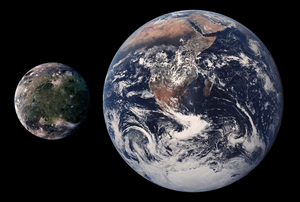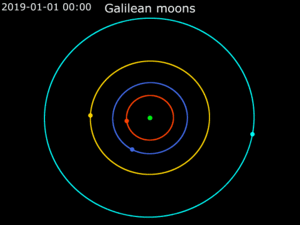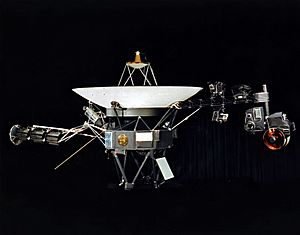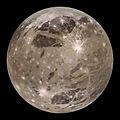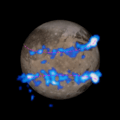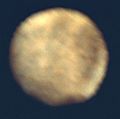Ganymede (moon) facts for kids

Click image for description
|
|
| Discovery | |
|---|---|
| Discovered by | G. Galilei S. Marius |
| Discovery date | January 11, 1610 |
| Orbital characteristics | |
| Periapsis | 1,069,200 km (0.007147 AU) |
| Apoapsis | 1,071,600 km (0.007163 AU) |
|
Mean orbit radius
|
1,070,400 km (0.007155 AU) |
| Eccentricity | 0.002 |
| 7.15455296 d (0.019588 a) | |
|
Average orbital speed
|
10.880 km/s |
| Inclination | 2.21° (to the ecliptic) 0.20° (to Jupiter's equator) |
| Satellite of | Jupiter |
| Physical characteristics | |
|
Mean radius
|
2631.2 km (0.413 Earths) |
| 87.0 million km² (0.171 Earths) | |
| Volume | 7.6×1010 km³ |
| Mass | 1.4819×1023 kg (0.025 Earths) |
|
Mean density
|
1.942 g/cm³ |
| 1.428 m/s2 (0.146 g) | |
| 2.741 km/s (6,130 mph) | |
| synchronous | |
| zero | |
| Albedo | 0.43 ± 0.02 |
| Temperature | ~109 K (−172 °C) |
| 4.61 (opposition) | |
| Atmosphere | |
|
Surface pressure
|
trace |
| Composition by volume | oxygen |
Ganymede is the largest moon in our Solar System. It orbits the giant planet Jupiter. Ganymede is so big that it's even larger than the planet Mercury!
This amazing moon is special because it's the only moon we know of that has its own magnetic field. This magnetic field is created by a metallic core deep inside Ganymede.
Ganymede is one of Jupiter's four largest moons, known as the Galilean moons. These moons were first seen by Galileo Galilei on January 7, 1610. The name "Ganymede" was suggested by astronomer Simon Marius. It comes from a story in Greek mythology about a young man named Ganymede.
Scientists have explored Ganymede using several spacecraft. The Pioneer 10 probe was one of the first to visit. Later, the Voyager 1 and Voyager 2 probes helped us learn more about its size. The Galileo spacecraft made exciting discoveries, like finding an ocean hidden under Ganymede's surface and confirming its magnetic field.
A new mission called the Jupiter Icy Moons Explorer (JUICE) is planned by the European Space Agency. It launched in 2023 and will study Ganymede and other icy moons of Jupiter.
Contents
What Ganymede is Like
Ganymede is about 5,262 kilometers (3,270 miles) wide. That's about 0.4 times the width of Earth. It's made of about half rock and half water ice.
Ganymede's outer layer, its crust, is made of water ice. This icy crust is broken into large pieces, much like Earth's crust is broken into plates. These plates can move around. Where they crash together, they form mountain ranges.
Because the icy crust can slowly move, impact craters on Ganymede tend to look flatter over time. Deep inside, Ganymede has a core made of iron. It also has a huge ocean hidden beneath its icy surface. This ocean might hold more water than all of Earth's oceans combined!
Surface Features
Ganymede's surface has two main types of areas. About one-third of the moon is covered in dark, old regions. These areas are full of impact craters from billions of years ago.
The other parts of the surface are lighter in color. These areas have many grooves and ridges. They are also very old, but not quite as old as the dark regions. Scientists think these lighter areas were shaped by tectonic activity. This activity might have been caused by tidal heating from Jupiter's strong gravity.
Thin Atmosphere
Ganymede has a very thin atmosphere. It contains oxygen and a small amount of atomic hydrogen. Scientists are still studying if it has an ionosphere, which is a layer of charged particles.
Ganymede also has bright areas at its poles, like Earth's polar caps. These are probably made of water frost. The Voyager spacecraft first spotted these polar caps.
Craters and Plains
You can see craters on both types of terrain on Ganymede. They are especially common in the dark, old regions. One important feature is a dark plain called Galileo Regio. It has many circular grooves, or furrows. These were likely formed during a time when the moon was geologically active.
Hidden Oceans of Ganymede
Back in the 1970s, scientists thought Ganymede might have a thick ocean. They believed it was located between two layers of ice. One ice layer would be on the surface, and another would be below the liquid ocean, resting on the rocky center.
In the 1990s, NASA's Galileo mission flew past Ganymede. It confirmed that there is indeed an ocean under the moon's surface. A study in 2014 suggested that Ganymede might even have several ocean layers. These layers could be separated by different types of ice.
In 2015, scientists used the Hubble Space Telescope to study Ganymede's aurorae. These are like the Northern Lights on Earth. They found that the way the aurorae moved suggested a salty ocean under the surface. A large saltwater ocean would affect Ganymede's magnetic field, which then changes its aurora.
The evidence suggests that Ganymede's oceans might be the biggest in the entire Solar System! Some scientists even wonder if this hidden ocean could support life.
How Ganymede Moves
It takes Ganymede about 7.15 Earth days to travel once around Jupiter. Ganymede spins at the same speed it orbits Jupiter. This means that one "day" on Ganymede is also about 7.15 Earth days long.
Like most moons, Ganymede is "tidally locked" to its planet. This means that one side of Ganymede always faces Jupiter, just like our Moon always shows the same face to Earth.
Future Missions to Ganymede
Scientists are planning more missions to explore Ganymede. One idea was the Europa Jupiter System Mission (EJSM). This was a joint plan between NASA and the ESA. It aimed to explore many of Jupiter's moons, including Ganymede.
The European part of this mission was renamed the Jupiter Icy Moons Explorer (JUICE). It launched in 2023. This spacecraft will orbit Ganymede. It will also fly past Jupiter's other icy moons, Callisto and Europa, to study them closely.
The Russian Space Research Institute is also thinking about a mission called the Ganymede Lander (GL). This mission would focus on astrobiology, which is the study of life in space. The Ganymede Lander could be a partner mission to JUICE. If it's approved, it might launch a few years after JUICE.
Images for kids
-
Laplace resonance of Ganymede, Europa, and Io (conjunctions are highlighted by color changes)
-
Three detailed views of Ganymede taken by Voyager 1 on July 9, 1979.
-
Ganymede as seen from Pioneer 10 in 1973.
See also
 In Spanish: Ganimedes (satélite) para niños
In Spanish: Ganimedes (satélite) para niños



